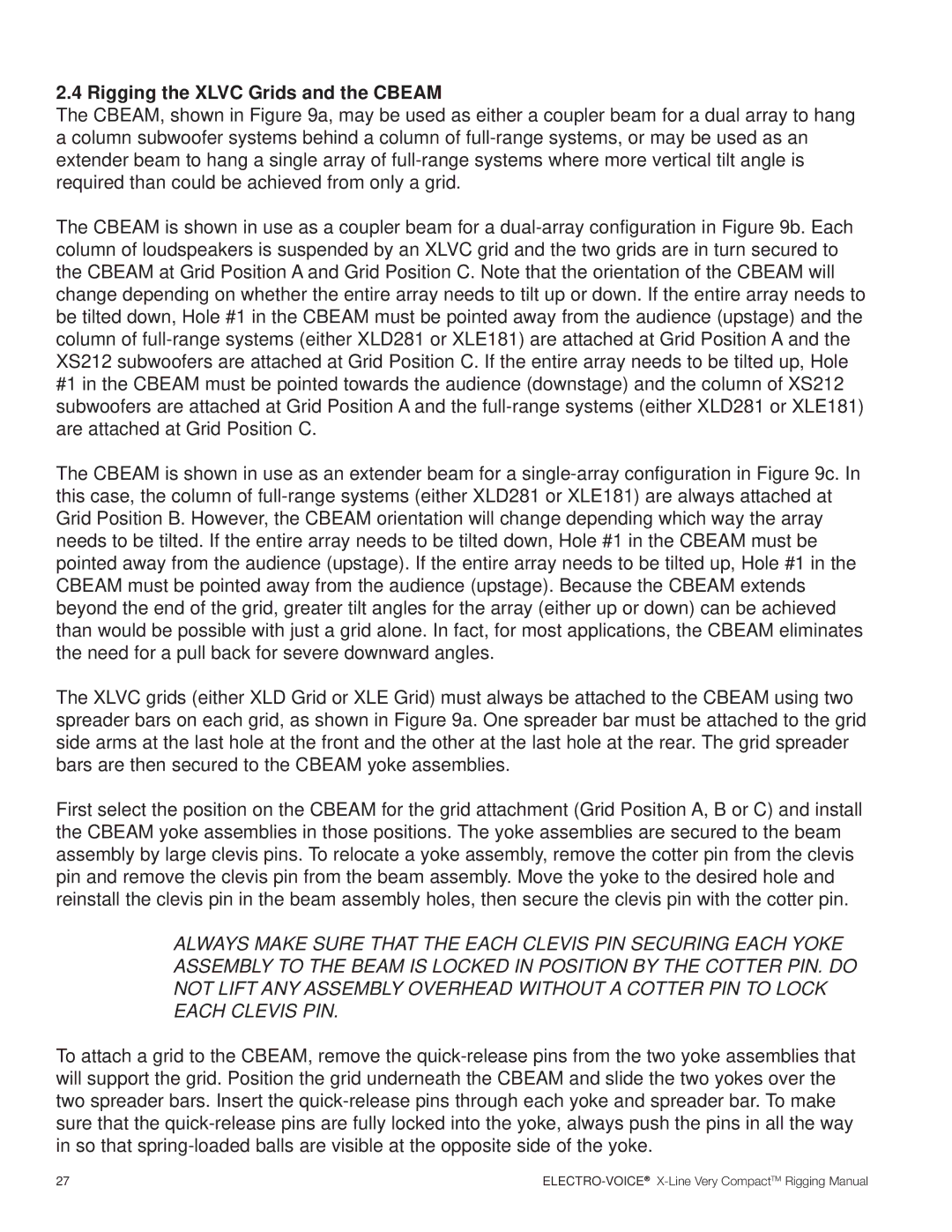2.4 Rigging the XLVC Grids and the CBEAM
The CBEAM, shown in Figure 9a, may be used as either a coupler beam for a dual array to hang a column subwoofer systems behind a column of full-range systems, or may be used as an extender beam to hang a single array of full-range systems where more vertical tilt angle is required than could be achieved from only a grid.
The CBEAM is shown in use as a coupler beam for a dual-array configuration in Figure 9b. Each column of loudspeakers is suspended by an XLVC grid and the two grids are in turn secured to the CBEAM at Grid Position A and Grid Position C. Note that the orientation of the CBEAM will change depending on whether the entire array needs to tilt up or down. If the entire array needs to be tilted down, Hole #1 in the CBEAM must be pointed away from the audience (upstage) and the column of full-range systems (either XLD281 or XLE181) are attached at Grid Position A and the XS212 subwoofers are attached at Grid Position C. If the entire array needs to be tilted up, Hole #1 in the CBEAM must be pointed towards the audience (downstage) and the column of XS212 subwoofers are attached at Grid Position A and the full-range systems (either XLD281 or XLE181) are attached at Grid Position C.
The CBEAM is shown in use as an extender beam for a single-array configuration in Figure 9c. In this case, the column of full-range systems (either XLD281 or XLE181) are always attached at Grid Position B. However, the CBEAM orientation will change depending which way the array needs to be tilted. If the entire array needs to be tilted down, Hole #1 in the CBEAM must be pointed away from the audience (upstage). If the entire array needs to be tilted up, Hole #1 in the CBEAM must be pointed away from the audience (upstage). Because the CBEAM extends beyond the end of the grid, greater tilt angles for the array (either up or down) can be achieved than would be possible with just a grid alone. In fact, for most applications, the CBEAM eliminates the need for a pull back for severe downward angles.
The XLVC grids (either XLD Grid or XLE Grid) must always be attached to the CBEAM using two spreader bars on each grid, as shown in Figure 9a. One spreader bar must be attached to the grid side arms at the last hole at the front and the other at the last hole at the rear. The grid spreader bars are then secured to the CBEAM yoke assemblies.
First select the position on the CBEAM for the grid attachment (Grid Position A, B or C) and install the CBEAM yoke assemblies in those positions. The yoke assemblies are secured to the beam assembly by large clevis pins. To relocate a yoke assembly, remove the cotter pin from the clevis pin and remove the clevis pin from the beam assembly. Move the yoke to the desired hole and reinstall the clevis pin in the beam assembly holes, then secure the clevis pin with the cotter pin.
ALWAYS MAKE SURE THAT THE EACH CLEVIS PIN SECURING EACH YOKE ASSEMBLY TO THE BEAM IS LOCKED IN POSITION BY THE COTTER PIN. DO NOT LIFT ANY ASSEMBLY OVERHEAD WITHOUT A COTTER PIN TO LOCK EACH CLEVIS PIN.
To attach a grid to the CBEAM, remove the quick-release pins from the two yoke assemblies that will support the grid. Position the grid underneath the CBEAM and slide the two yokes over the two spreader bars. Insert the quick-release pins through each yoke and spreader bar. To make sure that the quick-release pins are fully locked into the yoke, always push the pins in all the way in so that spring-loaded balls are visible at the opposite side of the yoke.

